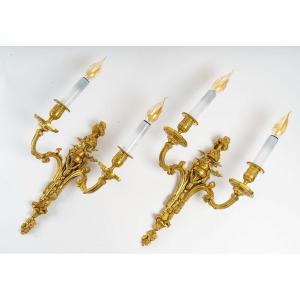A rare and elegant pair of sconces in the Louis XVI style with two arms of light in finely chiseled and gilded bronze, the shaft in console decorated with sharp eagle claws, surmounted by a hat with feather and a face, cups, and binnacles with interlacing motifs.
Beautiful French work of the 19th century, stamp of the House Beurdeley and stamp of foundry Syndicat Des Fabricants De Bronze, United France.
Sizes: Height 15.74 In. - Wide 12.20 In. - Deep 5.90 In.
Our sconces are in a very fine original condition, in their original gilding. They have been electrified to European standards and receive white opalines simulating candles.
Biography:
The Beurdeleys constitute one of the most important dynasties of luxury furniture makers of the 19th century, spanning three generations.
From a modest family, Jean Beurdeley (1772-1853) established himself in 1804 in the rue Saint Honoré as a dealer in curios and furniture made to order by the greatest craftsmen and later himself.
The business was taken over in 1840, after the store and workshop were moved to the corner of rue Louis Le Grand and Boulevard des Italiens, by his son Louis-Auguste-Alfred Beurdeley (1808-1882). The latter considerably developed the business, which became a place for the manufacture of high-quality furniture and participated in the first World Fairs held in Paris in 1855 and 1867, where he won a bronze medal and then a gold medal.
Supplier of the Imperial Furniture Guard, the company received several important official orders such as in 1853, on the occasion of the marriage of Emperor Napoleon III and Empress Eugenie, the creation of furniture, also presented at the World Fair of 1855, as well as furniture for the Tuileries palace or the Saint-Cloud castle.
The third and last of the dynasty, Alfred-Emmanuel-Louis Beurdeley (1847-1919) took over from his father in 1875 after having been his collaborator. He kept the store at the corner of rue Louis-le-Grand and boulevard des Italiens, the famous Pavillon de Hanovre, but moved his workshops to 20 and 24 rue Dautancourt. He specializes in the manufacture of luxury furniture copied on old models from the Mobilier National but with subtle variations, also realizes some original furniture and stands out for his quality of outstanding bronzier.
His participation in the World Fairs is also crowned with success, he wins in 1878 in Paris, a new gold medal, and is made Knight of the Legion of Honor in 1883 in Amsterdam. He exhibited again in Paris in 1889 and for the last time in Chicago in 1893 where he presented a copy of the king's desk by Œben and Risener.
Thanks to these awards, the reputation of his work was exported abroad, and the house, which was thus recognized worldwide, received, after royal and imperial orders, those of rich American industrialists such as the Vanderbilts, who had settled in New York, where a boutique was opened.
Cornelius Vanderbilt II bought his grandfather's house in New York in 1877 and at the beginning of 1890 launched an ambitious renovation and enlargement project using the best craftsmen in the world. Alfred-Emmanuel Beurdeley was therefore commissioned to create the furniture and various objets d'art to furnish the new Manhattan residence as well as the Newport cottage. For the businessman, he made a copy of a pair of consoles after Georges Jacob for the Count of Artois, a copy of Marie-Antoinette's table, and a mantelpiece inspired by Pierre Contant d'Ivry's model for the salon of the Duchess of Orleans at the Palais Royal, dating from 1752 - 1753.
The American adventure of the early 1890s marked the end of the Beurdeley company, as Alfred-Emmanuel liquidated his business in 1895. A large part of the furniture and works of art was dispersed at auction between 1897 and 1898, while the rest was kept to furnish his private mansion in the rue de Clichy. Art lover and great erudite collector, his collection of engravings was one of the most important in Europe at the end of the XIXth century with more than 28,000 prints. He sold a part of it 1888 composed of about 6000 architectural drawings to the Central Academy of Technical Drawing in St. Petersburg, now kept in the Hermitage Museum.
Bibliography:
Camille Mestdagh, L'ameublement d'art Français, 1850-1900, Paris,2010, p.128-129.
Christopher Payne, Paris, la quintessence du meuble au XIXème siècle, Saint-Remy-en-l’Eau, editions Monelle Hayot, 2018, p266-275.
Michael C. Kathrens, Great Houses of New York: 1880-1930, New York, 2005, pp. 38-4.

















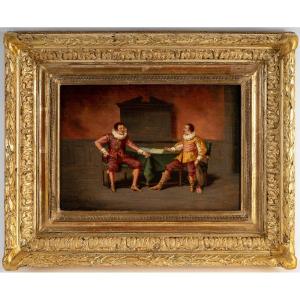

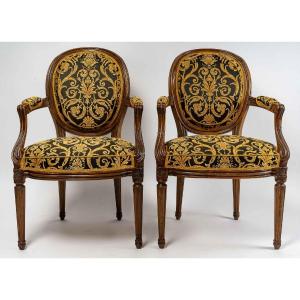



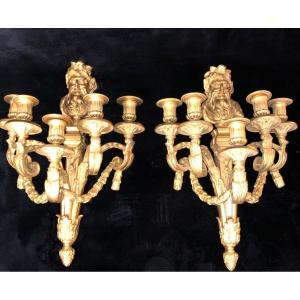


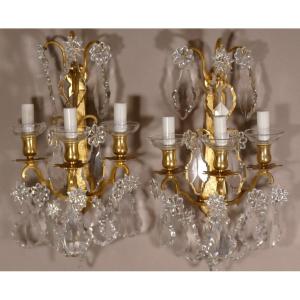



 Le Magazine de PROANTIC
Le Magazine de PROANTIC TRÉSORS Magazine
TRÉSORS Magazine Rivista Artiquariato
Rivista Artiquariato
